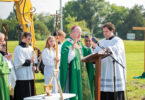Documentary shares legacy of Topeka mariachi band
by Marc and Julie Anderson
mjanderson@theleaven.org
TOPEKA — It’s a story of music and faith, of fun and friendship. It’s a story of seven women finding their place in the world, and a story of tragedy and loss.
It’s the story of Mariachi Estrella, one of the first all-female mariachi bands in the United States. Nearly 30 years later, their story lives on through a new documentary.
Although Christ the King parishioner Peter Jasso grew up on the other side of Topeka, he often danced at the annual Fiesta Mexicana, a fundraiser for what was then Our Lady of Guadalupe School. He frequently heard tales of Mariachi Estrella. The band’s story appealed to him, he said, perhaps due to his personal ties to the parish, his sense of a good story line, or a little of both.
Mariachi Estrella, while only officially a band for roughly a year, left an indelible mark on the parish, the Hispanic community and the mariachi music scene.
In the late 1970s, Teresa Cuevas, Connie Alcala, Isabel Gonzales, Rachel Galvan Sangalang, Linda Scurlock, Dolores Carmona and Dolores Galvan joined together to form Mariachi Estrella. The irony is the group never planned it.
“My sister Connie and I played with a men’s choir for about two years,” said Gonzales. The pair’s musical training was limited — a few guitar lessons for Gonzales and a few piano lessons for Alcala.
Eventually, the sisters formed their own group, more in the mariachi style, meaning the music was lively and upbeat, and featured instruments such as the guitar, guitarron and vihuela.
At the same time, Cuevas used to play every Sunday at the 8 a.m. Mass.
A convert to Catholicism, she felt called to use her talent for God. As both a child and teenager, she had played in school bands and orchestras. Divorced with young children, the music called to her as a means of maintaining her closeness to God.
“You have to have a good understanding of who God is,” said Cuevas. “God is in my heart and my mind. Every day, I keep close to him, and he keeps close to me.”
Gonzales, Alcala and Cuevas were eventually joined by the other women, including Scurlock, who, while not a parishioner, helped to round out the sound with her trumpet. The seven soon discovered their own sound and learned all they could about mariachi music, even studying at a mariachi music institute in California.
Ed Gonzales, brother of Carmona and a fellow parishioner, took the group under his wing, helping with rehearsals and costumes. Eventually, the group performed at parish events like the Fiesta Mexicana and other Midwestern venues.
“I think they loved mariachi music,” Cuevas said of the other women. “I just see them playing, and I remember how we sounded. I thought we were pretty good.”
That opinion was shared by record label executives. The group was on the verge of a record deal when tragedy struck.
On July 15, 1981, the band entertained crowds at the Fiesta Mexicana in Topeka. Tragically, just two days later, while the band was at the Hyatt Regency in downtown Kansas City, Mo., to perform at a corporate event for the Fuller Brush Co., the hotel’s skyways collapsed, killing Alcala, Carmona, Galvan and Scurlock.
More than 25 years later, it was the legacy of the all-female group that led independent filmmakers Jasso and his wife, Marlo Angell, to delve more deeply into the band’s story.
Raised in the community, Jasso could recall the broad outline of the tragedy, but soon found his knowledge only scratched the surface.
“If you start searching on the Internet for Mariachi Estrella, you will come up with dozens of hits,” he said.
“The musical genre of mariachi was very much a part of the culture in the sense that people listened to it, knew the songs, played recordings, etc.,” said Jasso. “And there were individuals that played these types of songs on a more ad hoc basis or as part of pickup bands, trios, or specially-created orchestras at the fiesta.
“What Mariachi Estrella brought to the community was a well-organized, consistent, local group that mirrored professional bands across the country and in Mexico,” he said.
Now, nearly 30 years after the appearance of Mariach Estrella, at least five or six organized mariachi groups perform throughout the city. Also, hundreds of women throughout the world have since joined the mariachi music scene, a scene traditionally reserved to men.
In fact, Angell said, the barriers surmounted by Mariachi Estrella are part of its legacy.
“Their contributions to music history should be recognized,” he said. “I feel this story is integral to the history of [the] Oakland [area of the city] and to Topeka, of course.
“But the appeal is greater than just our borders,” Angell continued. “It touches on gender issues and cultural themes, while simultaneously speaking to the very basic emotions of the human condition.
“There is love, loss, even a sense of rebirth when you get to see just how their music lives on through all the people their lives have touched.”
Even the filmmakers themselves were touched by the magic of the group’s music.
“One of our goals from the beginning,” said Angell, “was to have the film feel like a song itself, with the different movements and crescendos of emotions that you go through.
“I would listen to the ebb and flow of Mariachi Estrella’s songs that were recorded by KTWU as inspiration while I edited the images together, because I wanted to have that spirit of the music in the flow of the film.”
The film debuted March 20 at Washburn University in Topeka. A second screening is planned for June 4-5 at the Lawrence Arts Center. Due to national and international inquiries, the couple plans to take the documentary on the film festival circuit.
In the meantime though, Jasso and Angel said they were honored that surviving band members were pleased with the film.
“This is a very, very beautiful video,” Isabel Gonzales said. “It’s a gift not just to us and to the community, but also to history.”






